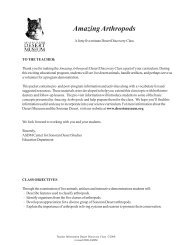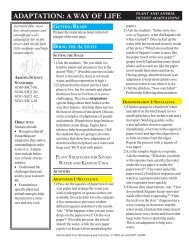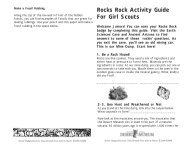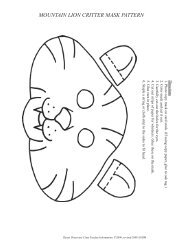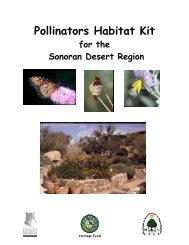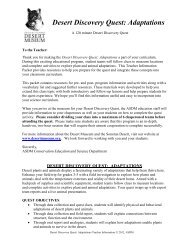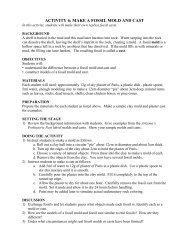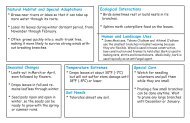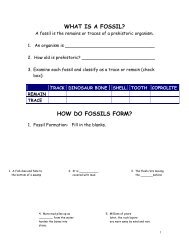Flower Dissection - Arizona-Sonora Desert Museum
Flower Dissection - Arizona-Sonora Desert Museum
Flower Dissection - Arizona-Sonora Desert Museum
Create successful ePaper yourself
Turn your PDF publications into a flip-book with our unique Google optimized e-Paper software.
FLOWER DISSECTIONStudents dissect avariety of flowers toidentify floral structures.ARIZONA SCIENCESTANDARDSSC02-S4C1-01&02OBJECTIVESStudents should:· Dissect flowers tolook at their parts.· Identify male andfemale reproductivestructures of a flower.· Identify petals andsepals of a flower.MATERIALS· A copy of StudentHandout - <strong>Flower</strong>Parts Page for eachstudent· A variety of flowersfor dissection, aboutthree per student· Buckets or vasesfor the flowers· Clear tape· Hand lenses· Pencils or pensVOCABULARYAntherFilamentOvaryPetalsPistilPollenSepalsStamenStigmaStyleBACKGROUNDNow that your students can conceptualizethe process of pollination, they will beready to observe the floral structures thathelp make it possible. By dissecting avariety of flowers and identifying theirparts, students will better understand themechanics of pollination.With Younger Students:Even the youngest students enjoy dissectingflowers and identifying their parts. With K-2 students, it is best to have them categorizeand identify only three main parts:petals, male parts, and female parts.There is no need to give the names of theindividual units that comprise the reproductivestructures.With older students:You may wish to have them identify thereproductive structures in more detail (i.e.have them find the anthers and filamentsor the stigma, style, and ovary of theirflowers.) Refer to the information on floralstructure in the teacher background informationfor descriptions of floral structures.GETTING READYMake a copy of Student Handout -<strong>Flower</strong> Parts Page for each student andfor your own demonstration. Assemble thematerials listed in the left margin of thispage. Florists will often donate browning orold flowers, which work fine. You cansupplement the throw-aways by purchasinga few new specimens that clearly showfloral structure. The best flower types todissect include lilies, tulips, daffodils,alstroemarias, and gladiolus. Avoid daisies,asters, calla lilies, roses, and iris, since theirfloral structure is not as easy to discern.You may wish to have your students bringflowers from home, as well, if they haveflowering plants in their yards. Set theflowers in large buckets or vases.DOING THE ACTIVITYSETTING THE STAGE1) Recall with your students your discussionof pollination. Ask, “What dopollinators carry from one flower to thenext?” (pollen) “What happens whenpollen lands on the female part of theflower?” (A fruit with seeds is produced.)2) Explain that today you are going to lookat the parts of the flowers that help makepollination happen. Point out the parts ona lily as you discuss them. With olderstudents, you may want to sketch afloral parts diagram on the board and goover the names of the parts using boththe diagram and the lily.Male parts (stamens)anther (makes pollen)filamentFemale parts (pistil)stigmastyleovary (eggs inside)3) Ask, “Does the pollen come from themale or female parts of the flower?”(male) Show the pollen-laden antherssuspended on their filaments. Rub somepollen on the students’ fingers.4) Point out the sticky stigma on the lilyand tell the students that this is where thepollen lands during pollination. Point toTeacher Information <strong>Desert</strong> Discovery Class ©2000, revised 2008 ASDM
FLOWER DISSECTIONwhere the undeveloped seeds are found in the ovaryand explain that this develops into the fruit and seedsafter pollination.5) Show the petals and sepals, explaining their function.Tell them that on the lily, the sepals look thesame as the petals. Pick out another flower withobvious, green sepals to show that sepals can lookvery different.6) Explain that you are all going to take a flower apart,step by step, to see the different parts up close.DISSECTING FLOWERS1) Give each student a copy of Student Handout -<strong>Flower</strong> Parts Page, pass out tape and hand lenses,and instruct the students to each choose two or threedifferent flowers. Remind them that the group will gothrough all the steps together. Make sure no onestarts tearing apart their flower too soon. Followthese steps:1. Starting with the sepals and petals, carefully pullapart the flower.2. You may want to point out the sepals to olderstudents. (Sepals are the first or outermost tissueyou encounter on the stem at the base of theflower. They protect the flower bud before itopens and support the flower later. They are oftenthe same color as the petals.)3. Take one of the petals and tape it in the “petals”square on your flower parts page.4. Choose one of the male parts (stamens) from theflower. (For kindergarten students, refer to theseas “boy” parts.) Look at the pollen inside theanthers on top of the filaments with a hand lens. Ifthere is enough pollen, shake some of the pollenonto your page in the “male parts” square. Takeanother intact stamen fromyour flower and tape it in the“male parts” square. (Forolder students, you may wantto have them label the individualparts on their sheet.)5. Now they should see thefemale parts (pistil) of theflower. (For kindergarten students, refer to theseas “girl” parts.) Feel the top part (stigma) to see ifit is sticky. Follow the tube-shaped tissue (style)down from the top with your finger until you reachthe rounded base (ovary). Carefully break openthe ovary with your fingernail and look closely forseeds or unfertilized eggs with the hand lens. Tapethese parts to the “female parts” square on yourhandout. (Again, you may want to have olderstudents label the parts.)2) Have the students follow the same procedure withtheir remaining flower(s). Circulate around the roomto help identify parts and be sure they are puttingthem in the right squares.DISCUSSION1) When the students have completed their pages, askthem questions about what they observed whiledissecting flowers. Discuss possible answers listed inparentheses.· Did any of the flower petals have lines or dots onthem? What do you think these might be for? (Manyflowers have lines or dots on them. These are callednectar guides. The petal acts as a landing pad for theinsect and the lines are like a map to show where tofind the nectar. Some insects see ultra-violet colors,so the nectar guides look brighter or different to themthan they do to us.)· Do some flowers have more male parts than others?(Yes. Some flowers have only a few stamens, whileothers of different kinds have many. Some flowersmay contain only male or only female parts, or nonfunctionalparts.)·Is the place where the pollen lands on the female partalways the same shape? (No. Stigmas can besmooth-edged, fringed, or lobed, depending on thekind of plant the flowers grow on. The differentsurfaces and shapes help the right kind of pollen stickto them.)·Does one flower usually have more male parts thanfemale parts? (yes) Why do you think this might beimportant? (The role of the male parts is to producepollen. The more male parts there are, the morepollen they produce, and the more densely they fillthe flower.This increases the chance that an animalmight touch them and pick up pollen when it comesin search of nectar.)Teacher Information <strong>Desert</strong> Discovery Class ©2000, revised 2008 ASDM



